
|
|
SUBSIM: The Web's #1 resource for all submarine & naval simulations since 1997
 |
SUBSIM: The Web's #1 resource for all submarine & naval simulations since 1997 |
 06-01-18, 11:53 AM
06-01-18, 11:53 AM
|
#1 |
|
Watch Officer
 Join Date: Apr 2005
Location: massachusetts
Posts: 334
Downloads: 237
Uploads: 0
|
i had to split this post into 2 parts, there are 42 pics, subsim only allows 30 pics in one post
Somewhere i had read, (think it was the torpedo fire control manual), that during world war two, some of the submarine captains got pretty adept at using the TDC, so that got me thinking maybe theres more to the tdc then what we use it for, namely the torpedo solution. i began to mess around with the tdc, and i learned a few things we can do with it that relates to the fire control solution, like adding a value of the torpedo solution using the tdc's angle solver to determine AOB when its practically handed to us in two special cases, and some other things as well. i wanted to write about this and share this information with you, so that if you want, you can add these things to your tactical toolbox. this is not to replace your own firing methods or ways to aquire data, because just like your doctors, if you like them you can keep them, but there's value in learning as much as possible of the capabilities of the tdc, what it can and cannot do, can we set conditions on the tdc and manipulate it to give us an estimation of some unknown value we want to know, i'm going to write about some below, but i'm sure theres more, and i will find them, but i'm also putting this out for you in hopes it inspires you, to look into other ways the tdc may be used, after all, hundreds of heads are better than one. the last item discussed in this post is going to be the constant bearing firing method, this is not just waiting for a target to cross the vertical wire and then shooting, this is active shooting, you can feel the pressure and excitment that the submarines commanders must have felt while shooting, its also alot of fun, the constant bearing method was probably the most popular method u.s. submarine commanders used for shooting, it certainly was the method used by Tang and Wahoo, its quite clear from the book "clear the bridge" by captain okane. below one of many quotes from "clear the bridge" mentioning constant bearing method. “ Stand by for constant bearings . Up scope . ” Jones brought it up smartly , all the way . The freighter had no chance of spotting our two feet of scope in this chop .“Constant bearing—mark!” “Set!” “Fire!” Her mainmast had touched the wire, and our first torpedo zinged on its way. The second went to her foremast. The range on firing was 1,250, the track 90". O'Kane, Richard. Clear the Bridge!: The War Patrols of the U.S.S. Tang (Kindle Locations 4098-4101). Random House Publishing Group. Kindle Edition. ( think about this for a minute, he was deeper than periscope depth, becus the periscope when fully extended at periscope depth is about 7 feet above the water, tang was a balao class, periscope depth 60 feet, he must have been at 65 feet. rather then come to periscope depth and raise the scope two feet out of the water, where a dip in that "chop" would expose not only the scope but the periscope shears as well as surface water disturbance, which would have a more crosssectional area from an angle on the target ship, and more likely to be spotted, tactically i would think, it wasn't only smart, its tactically perfect for the conditions). what im going to show you is the real deal, how morton and okane and others actually used the constant bearing method, in the above paragraph of the quote from the book, he fires at the targets mainmast, then he aims and fires forward to that at the foremast, this is a divergent spread, and the only way you can fire torpdeoes in a divergent spread is by the constant bearing method,( exception is firing torpedos with different offsets on each torpedo) any other firing method is a longitudinal spread. notice in that paragraph that the track is 90, the constant bearing method was made for the 90 track. the constant bearing method is actually two sides of a coin, it can be used two different ways, one way fires the divergent spread, the TFCM states that a divergent spread is almost impossible to avoid by evasive action if the torpedoes are spotted before impact, and the other way fires a longitudinal spread, but i will explain that later, so what im going to talk about in this post is: 1. zero the TDC for bow and stern tubes. 2. using the angle solver of the tdc to determine the AOB of a target in a parallel or perpendicular course relative to the submarine. 3. determining a speed value for the target in a parallel or perpendicular course using the radar or hydrophones by a formula from the torpedo fire control manual, ts = ss times sin LA divided by sin AOB ts = target speed, ss = submarine speed, LA = lead angle (bearing to target), AOB = angle on bow (targets AOB) 4. distance to horizon (at periscope depth with periscope fully extended) 5. use the tdc to simulate target solution problems. (training with the tdc) 6. the constant bearing firing method. (shooting) just a warning, this is going to be a long post. ZEROING THE TDC FOR BOW AND STERN TUBES when the game first starts, the tdc is zeroed to the bow tubes by default. at this point, any target coming from 270 thru zero to 90 degrees, or from 90 thru zero to 270(the extremes might be a challenge) can be hit with the bow tubes pretty easily, we can be stealthie in the approach. if you wanted to fire at a target that calls for the stern tubes, and use the bow tubes, you will have problems using the bow tubes, you may get a message, "cannot compute", or you may still hit the target, but you may have to do some wild maneuvering at speeds that may give away your position to the escorts before you could even get your shots off, by zeroing the tdc to the stern tubes, you maintain the stealth nature of the submarine to sneak up on the targets and escorts, and the targets AOB will be alot smaller, so for any target coming from 270 thru 180 to 90, or 90 thru 180 to 270 degrees, should have the stern tubes selected for the shot. zeroing the tdc tells the tdc which direction your looking from, the bow or the stern. to zero the tdc for stern tubes you.. 1. select a stern tube 2. rotate the periscope to 180 degrees 3. click the range and bearing tool button on the attack tool 4. set the range to something greater than or equal to 1000 yards 5. send the bearing and range to the tdc using the red send button on the attack tool and thats it, the tdc is zeroed for the stern tubes, you sent 180 degrees and a range >= 1000 yards. sometimes, if you dont add a range, it doesnt zero all the way, if that happens, click the send button a second time, it should zero after that. if you follow the steps in order, you should have no trouble getting it zeroed the first time, dont be surprised if you have to click the send button twice, thats a game issue. you wouldnt set the tdc for stern shooting unless a ship was coming, so when one shows up needing a stern torpedo, after zeroing, you need to send target bearing, range, aob, and speed to the tdc to complete the solution. to zero the tdc for bow tubes. 1. select a bow tube 2. rotate the periscope to 0 degrees 3. click the range and bearing tool button on the attack tool 4. set the range to something greater than or equal to 1000 yards 5. send the bearing and range to the tdc using the red send button on the attack tool the next four pics show the default, after zeroing the tdc for stern tubes, the stern torpedoe track angle of 180 degrees, and the last in the series shows the tdc zeroed back to the bow tubes. default 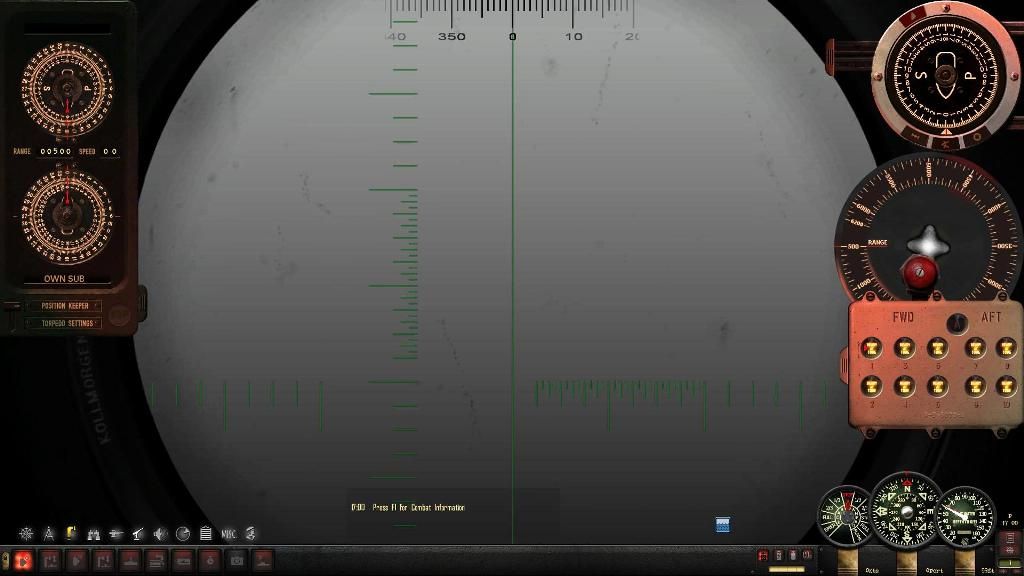 tdc is zeroed to stern torpedoes 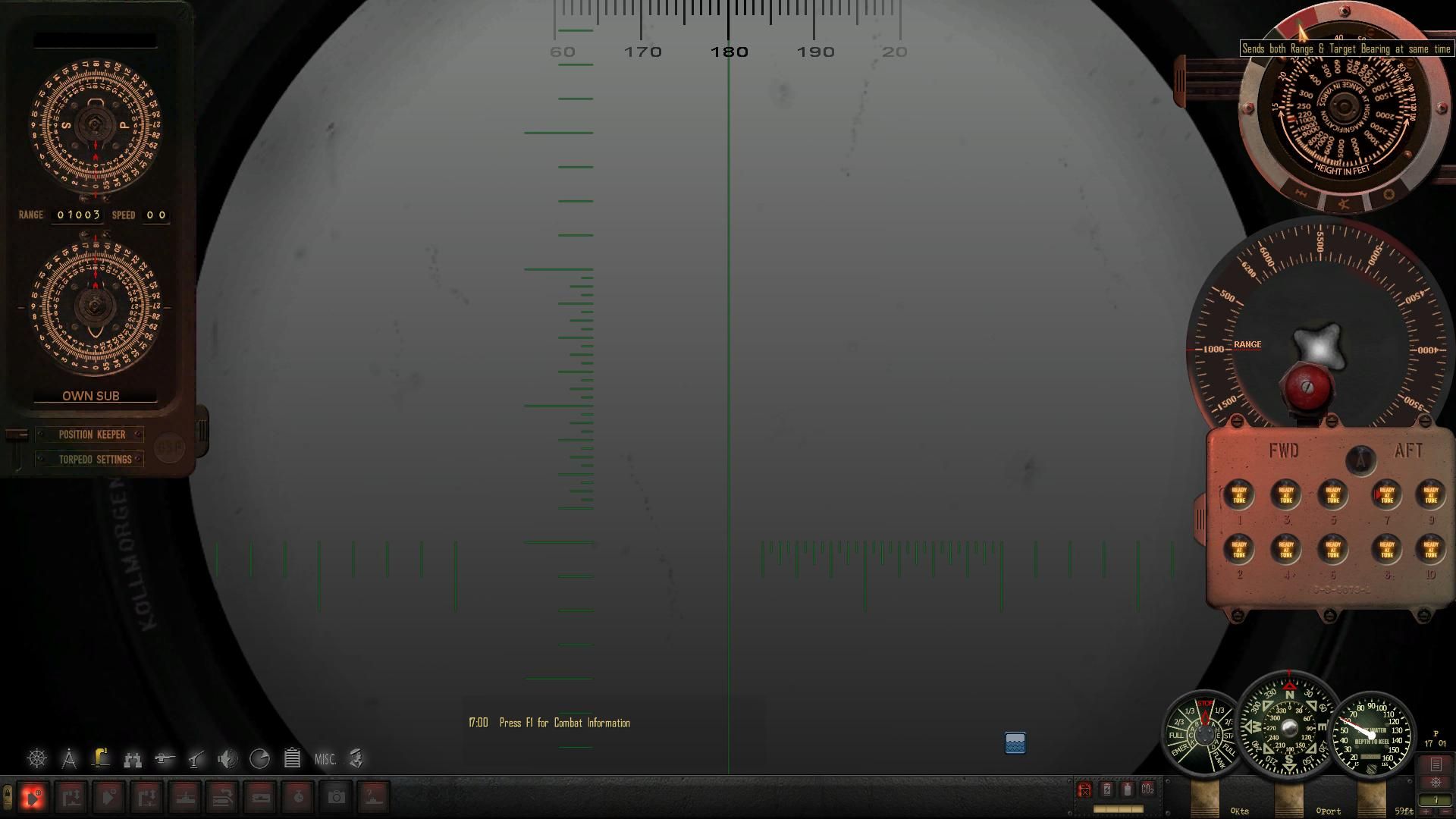 stern torpedo track is 180 degrees 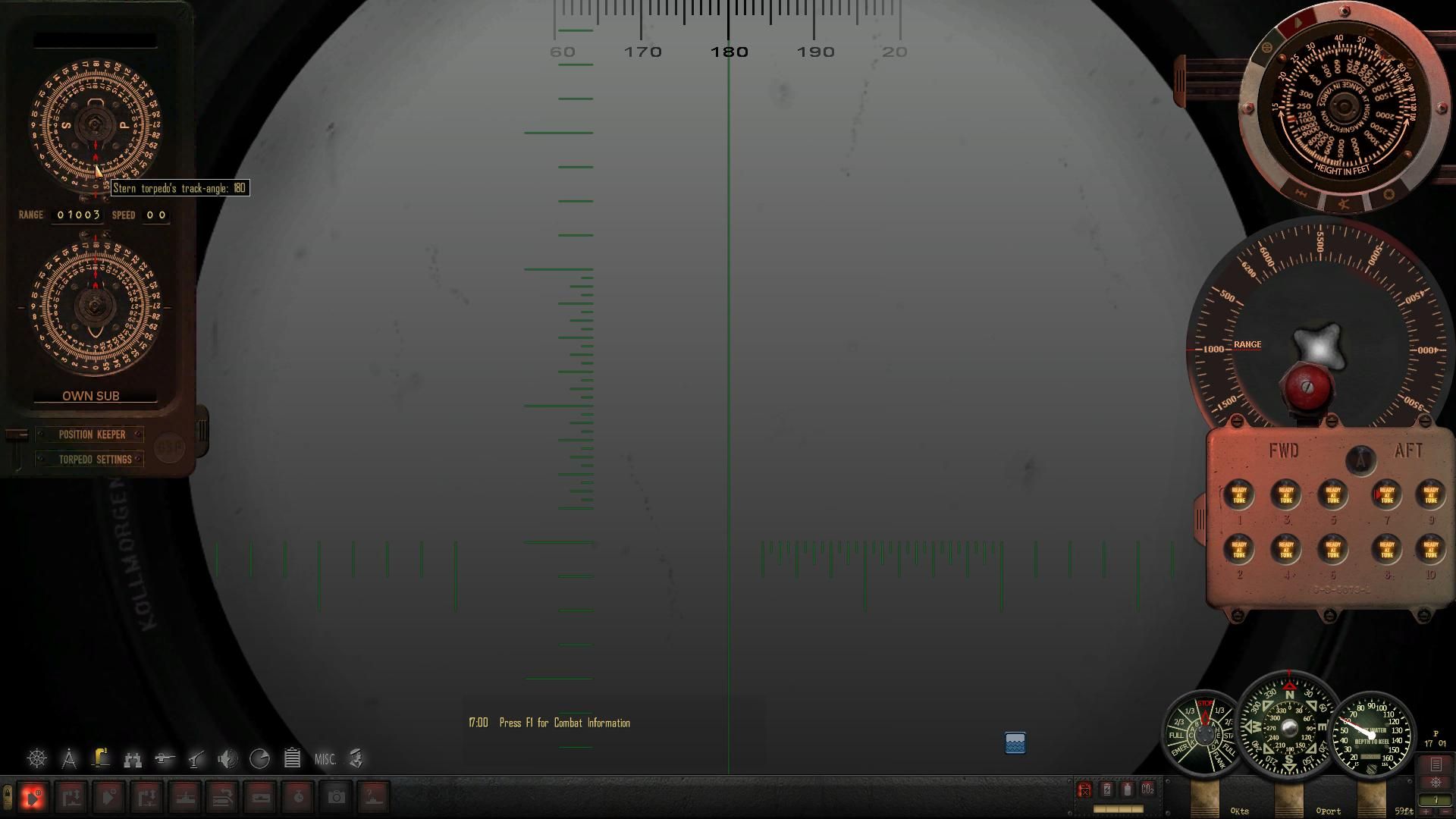 tdc reset to bow torpedoes  USING THE ANGLE SOLVER OF THE TDC TO DETERMINE AOB OF A TARGET IN A PARALLEL OR PERPENDICULAR COURSE RELATIVE TO SUBMARINE first of all, before i get into explaining how the angle solver of the tdc can help in certain situations, i just want to mention that any target course can be determined by the following procedure. 1. determine target bearing, if target bearing is less than 180 degrees, you add 180 degrees to the bearing, if its bearing is more than 180 degrees, you will subtract 180 degrees. 2. if the target has a port side AOB you will add its estimated aob, if it has a starboard AOB, you will subtract the aob. two examples of this: target bearing 20 degrees, is less than 180, so add 180, then the total becomes 200 degrees, target has 35 degree port AOB, so this amount gets added to the total of 200 degrees, and the target course becomes 235 degrees target bearing 220 degrees, is more than 180, so subtract 180, then the total becomes 40 degrees, target has a 35 degree starboard AOB, so this amount gets subtracted from the total of 40 degrees, and the targets course is 5 degrees. once the course is known, it can be plotted on the map, and then a submarine course can be plotted on the map or in your head to intercept. with that said, its time to move on to the angle solver. PARALLEL COURSE “ Captain , you put us in position , and we’ll blow her out of the sea ! ” Chief Torpedoman’s Mate Weekley had put his finger directly on our mutual responsibilities . I went forward to carry out mine , pausing in the messroom to look at our second plot ; Tang was moving in ahead . When I reached the bridge , the enemy was astern , with a sharp angle and on a parallel course . We had time for a final accurate check . O'Kane, Richard. Clear the Bridge!: The War Patrols of the U.S.S. Tang (Kindle Locations 4755-4759). Random House Publishing Group. Kindle Edition. below is a split pic of the radar and map view of the 11th patrol of my current campaign. this is the event that i will use to explain the constant bearing method later on in the post. the submarine is running parallel to the enemy course, therefore, enemy course is 279 true, becus the submarines course is 279 true. parallel lines have the same slope, but different y-intercepts, these lines, (courses) will never intersect.  enemy formation is on the port side, approximately 11,500 yards away, submarine will be dealing with degrees from 0 to 180 on the port side. what's seen here is that the lead angle is an obtuse angle, and the aob is an acute angle, together they are adjacent angles and together they make a linear pair. from geometry: adjacent angles are Two coplanar angles that have a common vertex, a common side, and when they are adjacent like this on the radar screen, they become a linear pair of angles. linear pair: Two angles that are adjacent and whose noncommon sides are opposite rays. linear pairs of angles are supplementary angles: Two angles with measure whose sum is 180. Each angle is called a supplement of the other. therefore both lead angle and aob angles have to add up to 180 degrees, opposite rays here are 0 degrees and 180 degrees. solid lines on the radar makes a good known bearing on the radar screen, to conduct estimations of speed and aob, the submarine is going faster than the enemy formation (20 knots), and creating distance. (from submarine's speed, enemy speed is less than 20 knots.) when the enemy's last ship in column falls back on bearing 210 degrees, (210 degrees is a solid line on the radar screen) thats where estimations of speed and aob will be taken, that is important using radar for speed estimation, the enemy ship position has to have a constant bearing for speed and a solid line on radar will help to see if the enemy ship drifts off the bearing. since its been preplanned where the estimations for speed and aob will be measured from, the bearing of 210 degrees can be entered into the tdc before the enemy gets there. rotating the periscope to the 210 degree bearing, clicking on the bearing and range button of the attack tool, then clicking the red send to tdc button. this sends the lead angle of 150 degrees to the tdc and then the tdc angle solver computes the aob, which is 30 degrees starboard, 360 - 210 = 150.......and 180 - 150 = 30. in the pic below, the target bearing of 210 degrees was send to the tdc, (thats all i did). please look at the pic and notice the position keeper, look at own ship inner dial, it reads 210 degrees, thats a lead angle of 150 degrees from the bow, please look at the target ship dial, you see the red arrow coming in at 150 degrees, so whats left in supplementary angles, 30 degrees, and theres the aob for the target, 30 degrees starboard, computed by the angle solver of the tdc, 180 - 150 = 30 or 150 + 30 = 180. the aob is literally handed to us in a parallel course. no matter what, in a parallel or perpendicular course, you will always know the aob by just looking at the bearing and determining whats left, with scope, hydrophones, or radar. 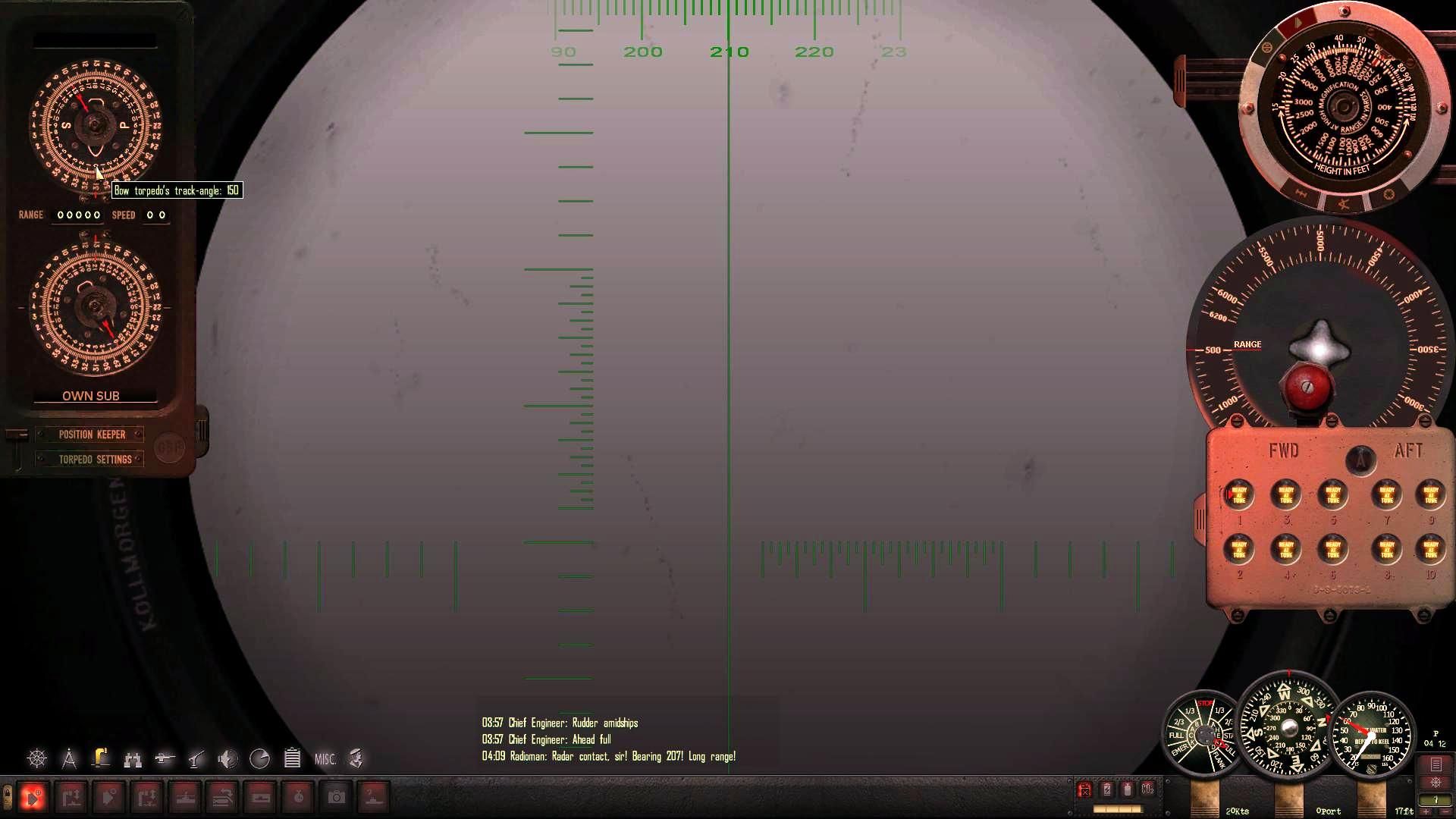 PERPENDICULAR COURSE it works the same way in the perpendicular, two adjacent angles adding together, but to a sum of 90 degrees, lead angle and aob, these angles are called complimentary angles. perpendicular (lines): Two lines that intersect to form right angles complementary angles: Two angles whose measures sum to 90, and are compliments to each other. the pic below shows a 80 degree lead angle on the periscope send to the tdc, own ship inner dial shows target bearing 80 degrees, target ship inner dial shows red arrow coming in at 80 degrees, complmentary angles must add to 90, and the aob is measured by the angle solver from 80 to 90 degrees, 80 + 10 = 90. theres no guesswork with AOB in a 90 target track. this simplicity in calling out the AOB'S makes sense after reading how captain okane called out AOB's decisively. 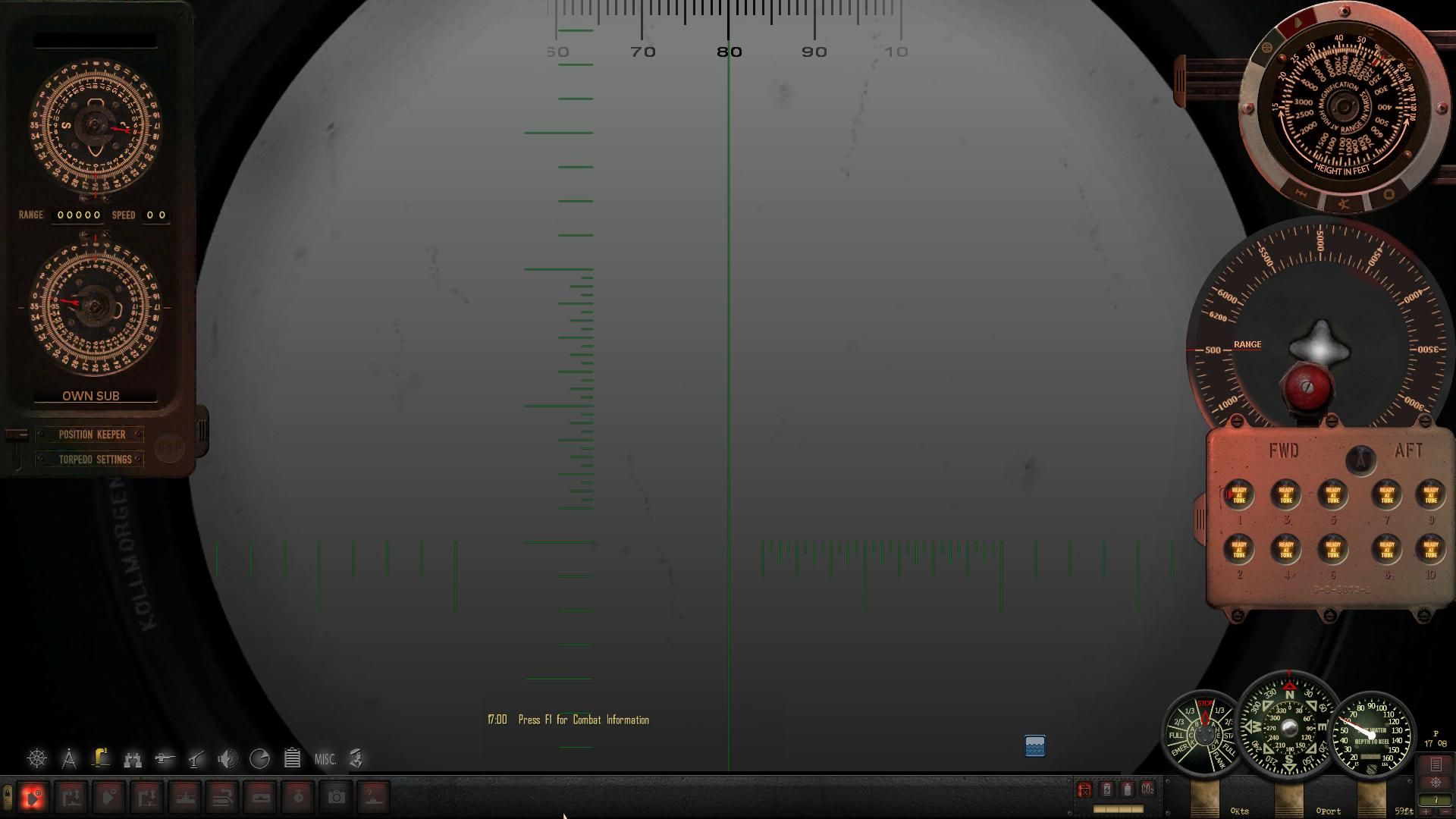 USING RADAR OR HYDROPHONES AND A MATH FORMULA TO DETERMINE TARGET SPEED IN PARALLEL AND PERPENDICULAR COURSES what is known about the enemy formation: course 279T degrees bearing 210R degrees aob 30S degrees speed unknown range unknown target speed is a value needed, in the torpedo fire control manual, there is a math formula to determine target speed, and a diagram, chapter 8, page 8-5. the following has been copied from the torpedo fire control manual. (a) Constant True Bearing (1) When the range is decreasing and the true bearing of the target remains constant the submarine and the target are on a collision course. In Plate XVI the true bearing is remaining constant at 015 degrees T and if both ships maintain course and speed they will collide at point A. (2) If during the period between two observations of the target the true bearing remains constant and the target has not changed course, the angle on the bow will remain the same. (3) If the target and the submarine have not changed course, the target has not changed speed, and the true bearing has remained constant over a period of 2 to 3 minutes, the target speed may be determined by the formula under plate XVI. looking at the diagram, in those days, it can be seen that it was stamped, "confidential", to be kept secret, implies it had value to the navy. 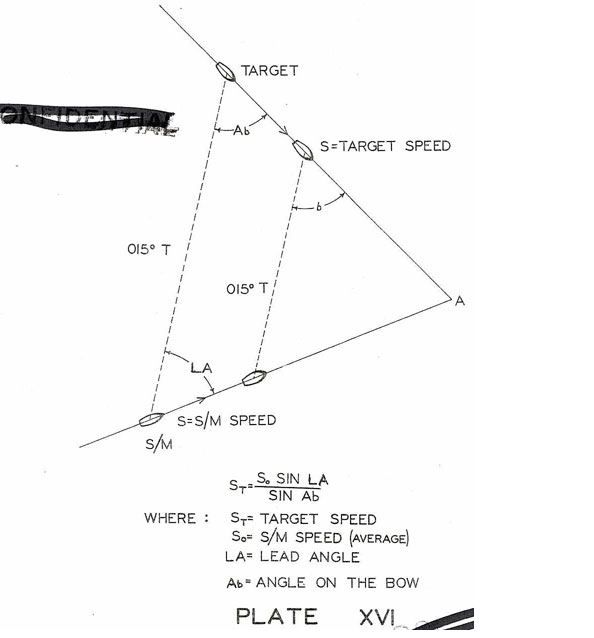 the math formula is shown in the diagram, it will be used with radar to determine target speed once the target drifts back to bearing 210, the pre-planned bearing, once the value of speed is determined, it can be set, or it can be set and send to the tdc. in the statement above from the TFCM, (1) can be ignored, as the submarine is parallel, (2) and (3) are the important factors here in a parallel course. (2) will be performed and (3) observed for, then substitute the values observed for the variables in the formula to come up with a value for target speed. ts = ss x sin LA / sin AOB where ts = target speed, ss = submarine speed, LA = lead angle (targets bearing), AOB = angle on bow (targets AOB). the submarines speed will drop to 17 knots, and try to establish a bracket, either its going to be a matched speed, or the enemy speed is greater than or less than 17 knots, the definition of what trichotomy means. in this case , 17 knots did'nt cut it, the enemy range decreased, so at least now its known, enemy speed is less than 20 knots, but more than 17 knots, enemy speed has to be 18 or 19 knots then. finding enemy speed from here by increasing submarine speed by one knot, each increment, until speed is matched, and range holds steady, and bearing remains constant. the best knotmeter to use for speed adjustments is the large one in the control room, and its tricky to set the speed sometimes, theres ranges of speeds to each speed on the speed telegraph, an example is if your try to set a slow speed, the speed telegraph would be in "AHEAD ONE THIRD" but if an increase in speed is needed, (manually from the knot meter) and that new speed setting crosses the treshhold, then the speed will jump to the highest "AHEAD TWO THIRDS" speed. another difficulty is setting fractional speeds, example 7.4 knots, it will be that if you click the knotmeter to 7.4 knots, the speed will get close, but not directly on, it may hold steady at 7.1 knots, then just click higher than 7.4 knots, like 7.8 knots to get speed up to 7.4 knots. the speeds set on the knot meter might not be very accurate at first setting, but working with the knotmeter will give precise speeds. in the next series of 4 pics, demonstrates the timing phase, the target is on bearing 210 degrees, pic one is the Beginning, the clock was just started, in pic 2, the radar screen after one minute, pic 3 is after 2 minutes, and pic 4 is after 3 minutes. after 3 minutes, the target ship's range and bearing held steady, and the knot meter reads 18.1 knots, so its a matched speed, therefore targets speed is 18 knots. arranged in the math formula, it becomes: ss times the sin LA / sin AOB = 18.1 times .5 / .5 = 18.1 knots, then target speed is 18.1 knots, or just 18 knots. 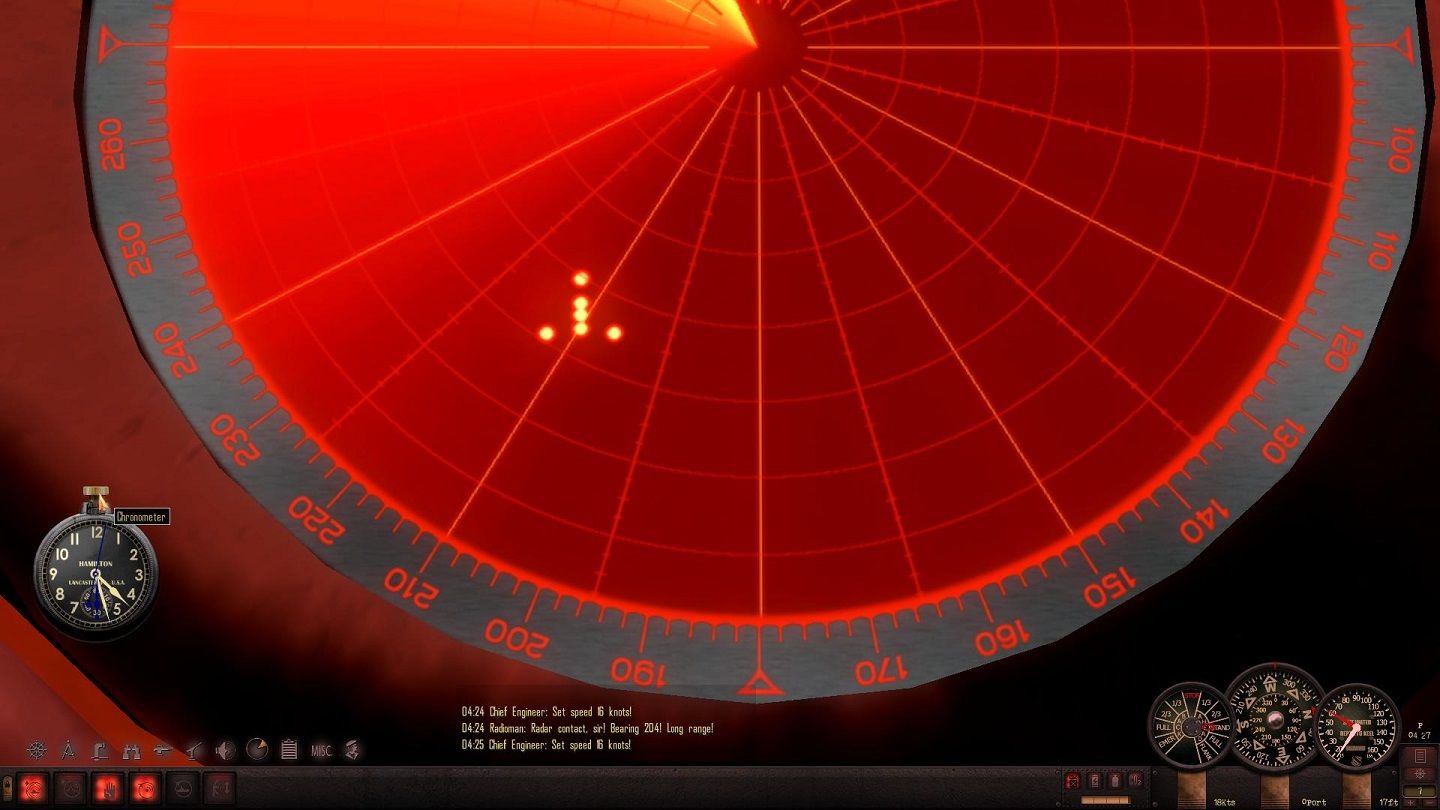 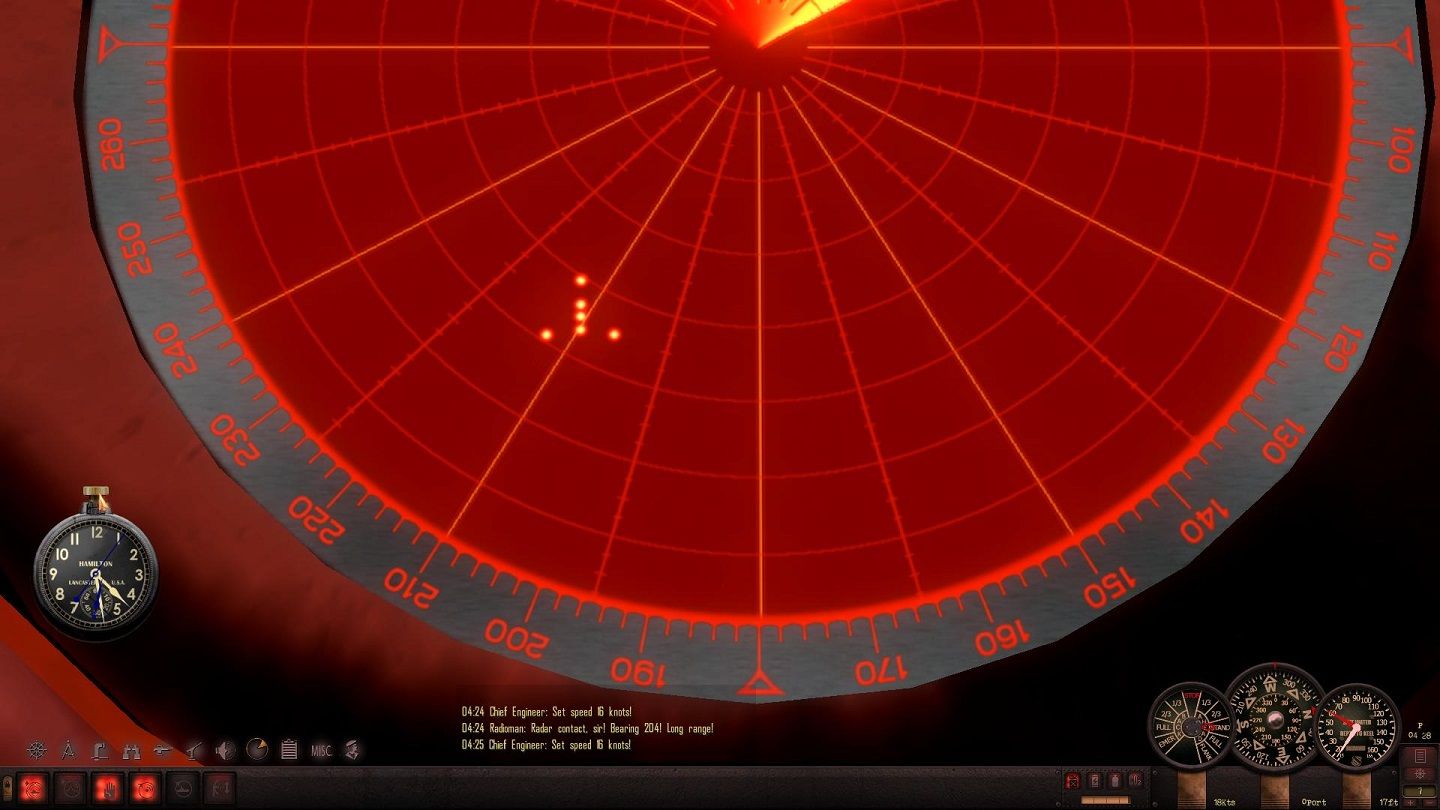 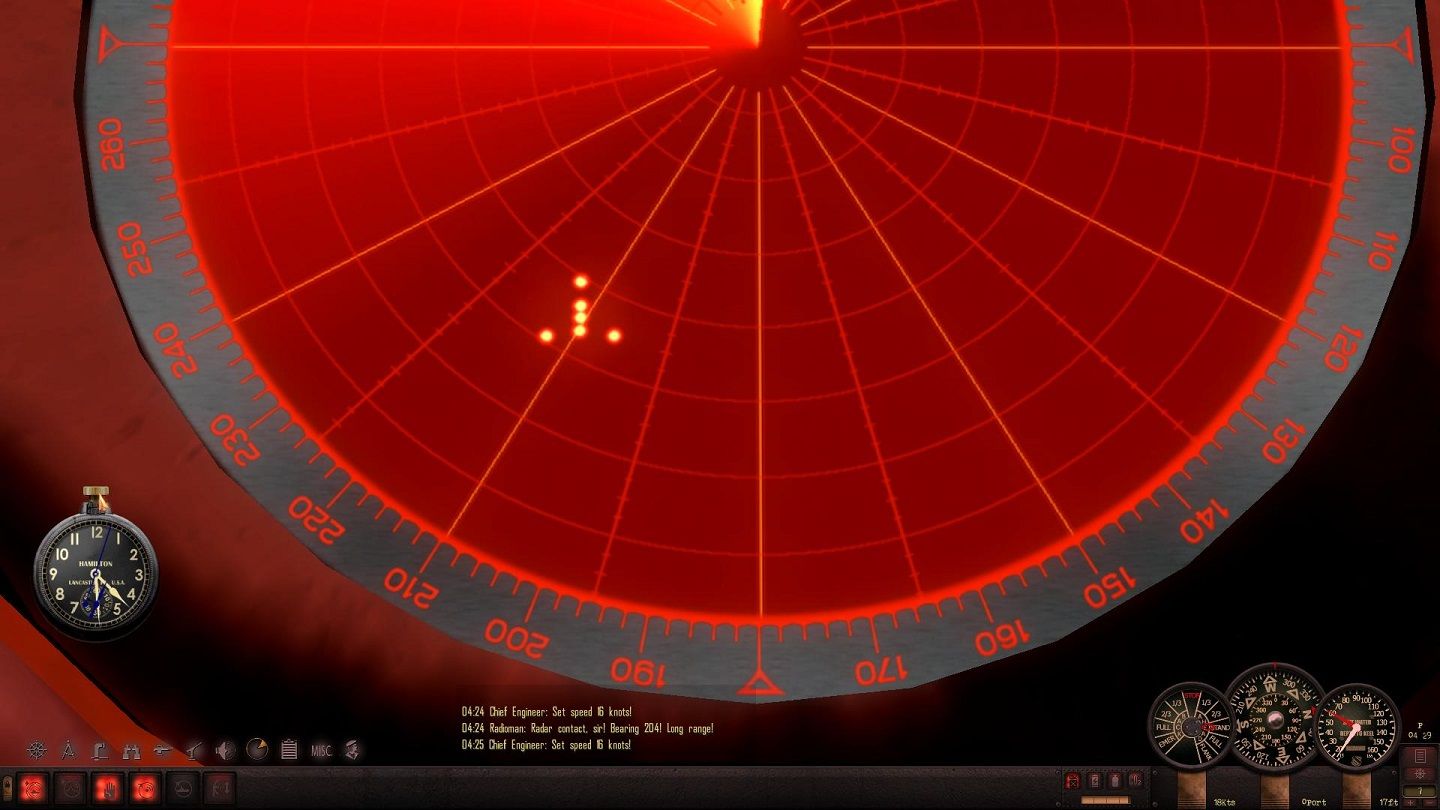 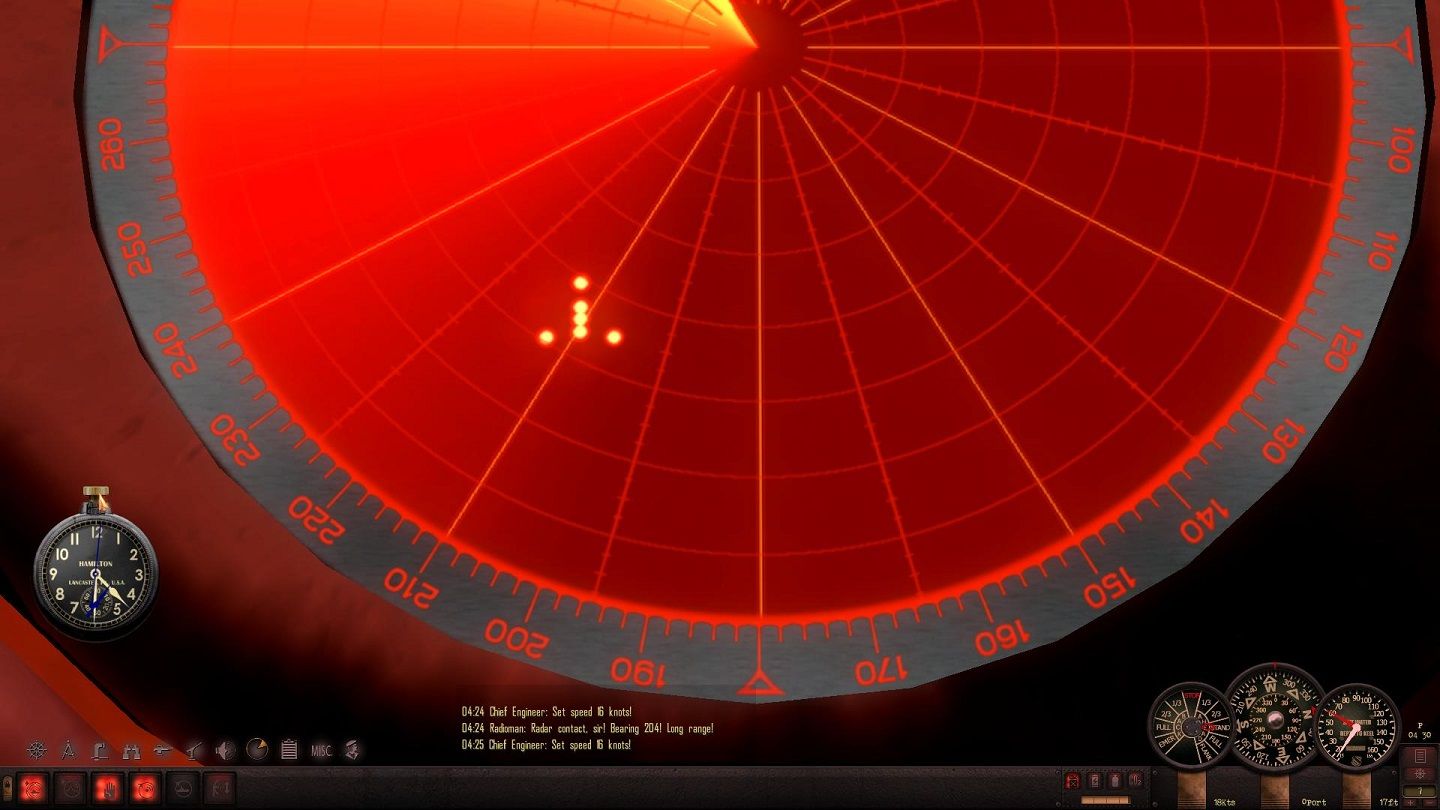 pic shows the speed on the knotmeter 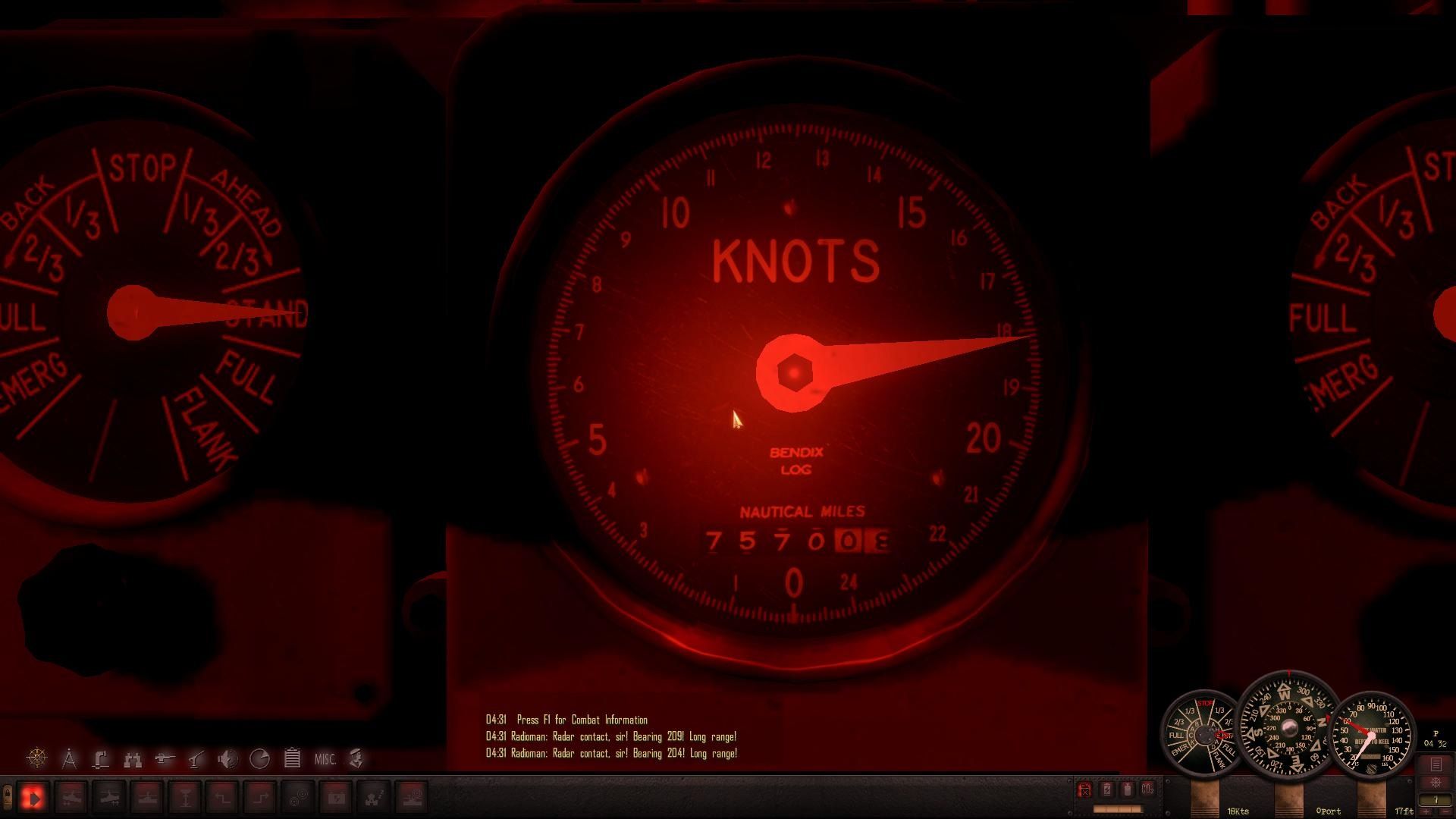 pic shows the a-scope view and ranges of the 3 ships in column. 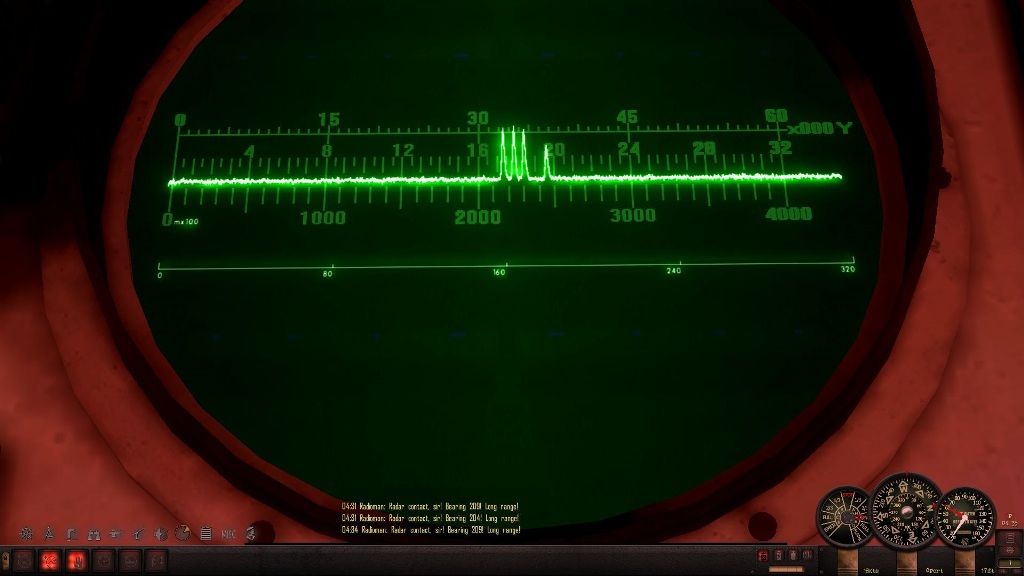 target ship plotted on the map. 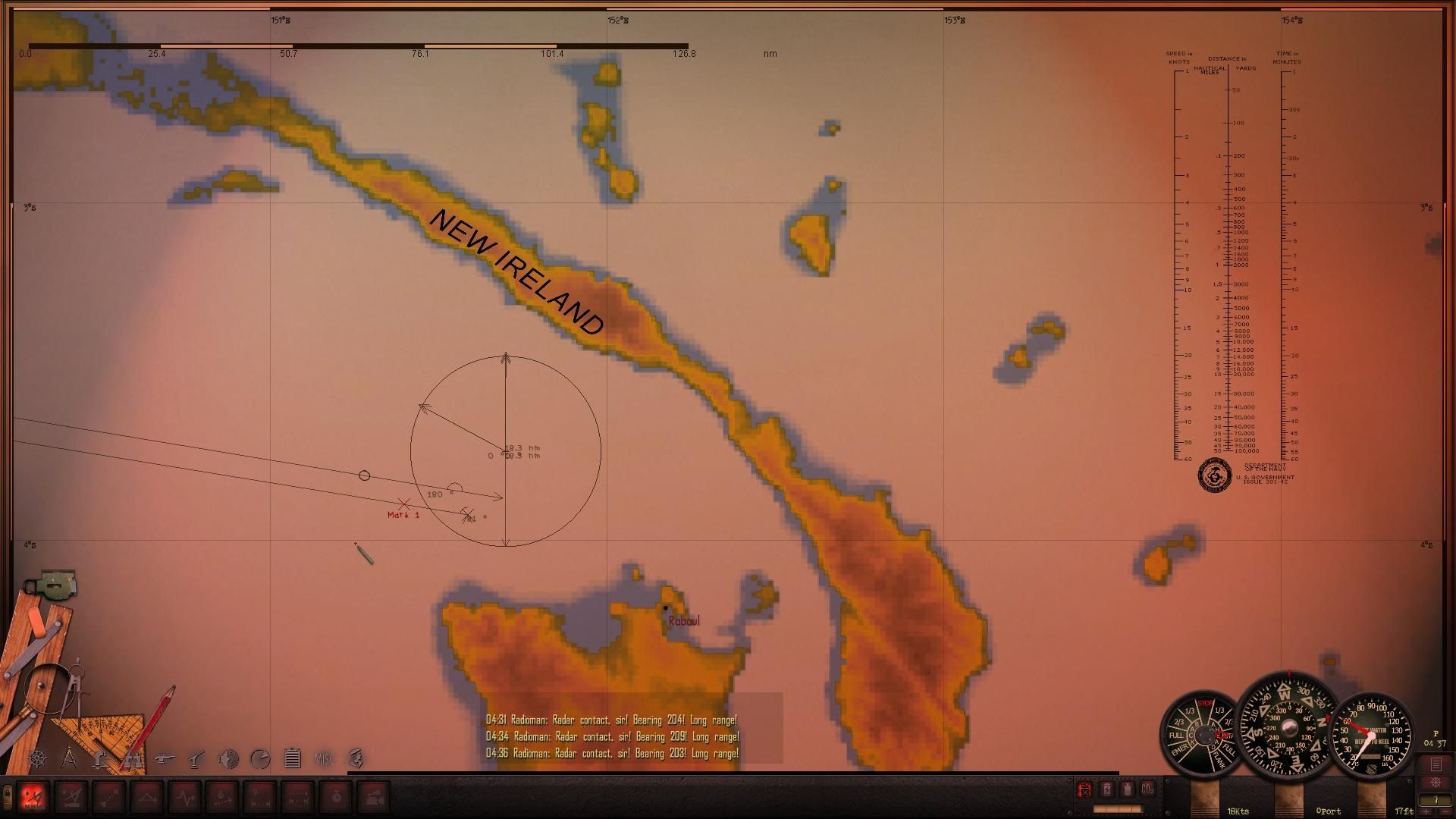 what is known about the enemy formation: course 279T degrees bearing 210R degrees aob 30S degrees speed 18 knots range 9.1 nm at a range of 9.1 nm, the width of bearing 210 is alittle less than 324.6 yards, as shown from a chart in the combat information mod, the width of 1 degree at 9.1 nm is 322.8 yards, that is quite abit of distance the target ship would have to travel in the vertical to fall off the bearing 210. sin of 1 degree times 18500 yards = 322.8 yards 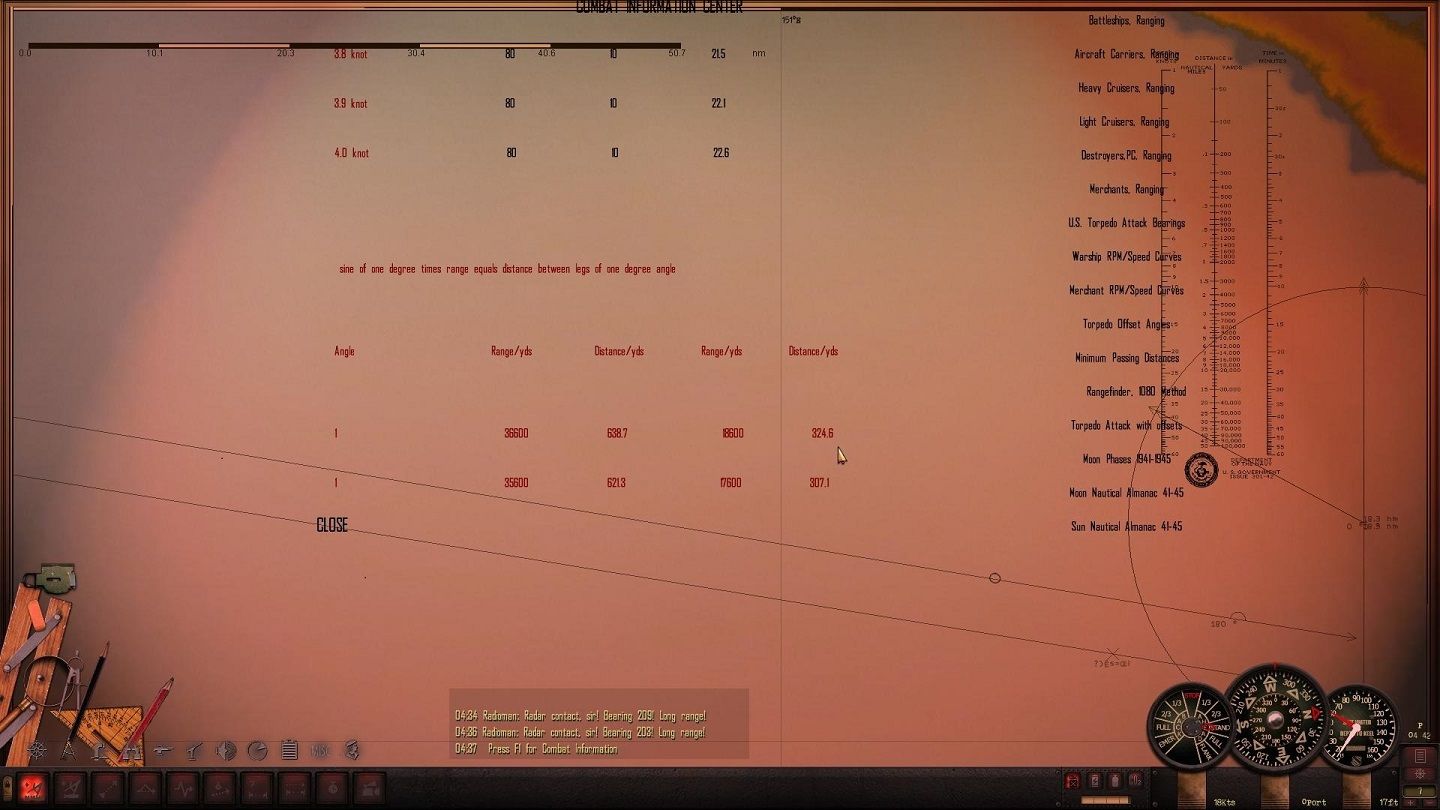
__________________
Her gun crew had guts, however, for from her canting bow came a half dozen well-aimed rounds. How they pointed and trained their gun on that tilting platform will long remain a wonder, and their dedication in keeping up the fire until they went under would be a matter of pride to any nation. O'Kane, Richard. Clear the Bridge!: The War Patrols of the U.S.S. Tang |

|

|
 |
| Thread Tools | |
| Display Modes | |
|
|
